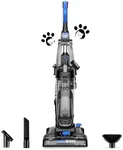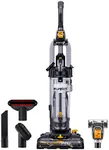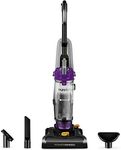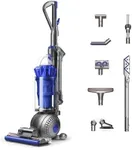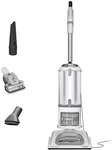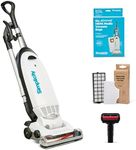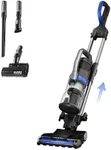Buying Guide for the Best Bagless Upright Vacuums
Choosing a bagless upright vacuum can make cleaning your home much easier and less expensive, as you won’t need to buy replacement bags. When selecting the right model, think about your home’s size, the types of surfaces you need to clean, whether you have pets, and how much storage space you have. The best vacuum for you should be easy to use, efficient at picking up dirt, and manageable to empty and maintain. Assess what features matter most to you before making a purchase.Suction PowerSuction power refers to the vacuum’s ability to pull in dirt, dust, and debris from surfaces. Stronger suction means better cleaning, especially for carpets and pet hair. Lower suction might be sufficient if you have mostly hard floors and minimal messes, while mid-range suction works well for homes with both carpets and hard floors. For households with pets or lots of carpets, high suction power is ideal. Consider your flooring types and cleaning needs to decide what level of suction is best for you.
Dust Bin CapacityThis is the amount of dirt the vacuum can hold before you need to empty it. Smaller bins are lighter and more compact, good for smaller homes or quick cleanups, but require more frequent emptying. Medium bins balance size and convenience, suitable for average homes. Large bins can handle more debris, making them a good choice for larger homes or those with pets and kids, but the vacuum itself may be bulkier. Think about how often you want to stop to empty the bin when choosing the right capacity.
Filtration SystemThe filtration system traps fine dust and allergens, making the air in your home cleaner. Basic filters capture larger dust and debris, which is enough for many people. More advanced systems, like HEPA filters, capture tiny particles and are best if you or someone in your home has allergies or asthma. If allergies are not a concern, a standard filter may be fine, but if air quality matters, look for models with high-efficiency filters.
Weight and ManeuverabilityWeight affects how easy it is to carry or push your vacuum, especially on stairs or around furniture. Lightweight vacuums are great for quick and easy cleaning or if you have trouble lifting heavy items. Medium-weight vacuums often strike a balance between power and ease of use. Heavier models may offer stronger suction or larger bins but can be harder to move. Consider how much you’ll need to lift or move your vacuum and your comfort level with heavier machines.
Height AdjustmentHeight adjustment lets you raise or lower the vacuum’s cleaning head to better match carpet thickness or hard floor surfaces. A vacuum with multiple height settings is more versatile and can transition smoothly between different floor types. If your home has a mix of flooring, look for adjustable height. For homes mostly with one floor type, a fixed or fewer height settings may be sufficient.
Attachments and ToolsAttachments like crevice tools, dusting brushes, and pet hair tools make your vacuum more versatile and able to clean different surfaces like furniture, stairs, and tight spaces. Basic attachments handle general cleaning jobs, while specialized tools are valuable for pet owners or detailed cleaning. If you need to clean more than just floors, choose a vacuum with a range of attachments that match your household needs.
Emptying MechanismThis refers to how you empty the dust bin. Some vacuums have easy-release buttons and bins that you can empty directly into the trash, while others may require more effort or come into closer contact with dust. Choose a model with a straightforward and hygienic emptying process, especially if you have dust allergies or prefer not to touch debris.


